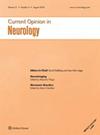Perception and control of a virtual body in immersive virtual reality for rehabilitation.
IF 4.1
2区 医学
Q1 CLINICAL NEUROLOGY
引用次数: 0
Abstract
PURPOSE OF REVIEW This review explores recent advances in using immersive virtual reality to improve bodily perception and motor control in rehabilitation across musculoskeletal and neurological conditions, examining how virtual reality's unique capabilities can address the challenges of traditional approaches. The potential in this area of the emerging metaverse and the integration of artificial intelligence in virtual reality are discussed. RECENT FINDINGS In musculoskeletal rehabilitation, virtual reality shows promise in enhancing motivation, adherence, improving range of motion, and reducing kinesiophobia, particularly postsurgery. For neurological conditions like stroke and spinal cord injury, virtual reality's ability to manipulate bodily perceptions offers significant therapeutic potential, with reported improvements in upper limb function and gait performance. Balance and gait rehabilitation, especially in older adults, have also seen positive outcomes. The integration of virtual reality with brain-computer interfaces presents exciting possibilities for severe speech and motor impairments. SUMMARY Current research is limited by small sample sizes, short intervention durations, and variability in virtual reality systems. Future studies should focus on larger, long-term trials to confirm findings and explore underlying mechanisms. As virtual reality technology advances, its integration into rehabilitation programs could revolutionize treatment approaches, personalizing treatments, facilitating home training, and potentially improving patient outcomes across a wide variety of conditions.在用于康复的沉浸式虚拟现实中感知和控制虚拟人体。
综述目的 本综述探讨了使用沉浸式虚拟现实技术改善肌肉骨骼和神经康复中的身体感知和运动控制的最新进展,研究了虚拟现实技术的独特功能如何应对传统方法所面临的挑战。在肌肉骨骼康复方面,虚拟现实技术在增强动力、坚持治疗、改善运动范围和减少运动恐惧症(尤其是手术后)方面大有可为。对于中风和脊髓损伤等神经系统疾病,虚拟现实操纵身体感知的能力提供了巨大的治疗潜力,据报道,上肢功能和步态表现都有所改善。平衡和步态康复,尤其是老年人的平衡和步态康复,也取得了积极的成果。虚拟现实与脑机接口的整合为严重的语言和运动障碍带来了令人兴奋的可能性。未来的研究应侧重于更大规模的长期试验,以确认研究结果并探索其潜在机制。随着虚拟现实技术的发展,将其整合到康复计划中可能会彻底改变治疗方法,实现个性化治疗,促进家庭训练,并有可能改善病人在各种情况下的治疗效果。
本文章由计算机程序翻译,如有差异,请以英文原文为准。
求助全文
约1分钟内获得全文
求助全文
来源期刊

Current Opinion in Neurology
医学-临床神经学
CiteScore
8.60
自引率
0.00%
发文量
174
审稿时长
6-12 weeks
期刊介绍:
Current Opinion in Neurology is a highly regarded journal offering insightful editorials and on-the-mark invited reviews; covering key subjects such as cerebrovascular disease, developmental disorders, neuroimaging and demyelinating diseases. Published bimonthly, each issue of Current Opinion in Neurology introduces world renowned guest editors and internationally recognized academics within the neurology field, delivering a widespread selection of expert assessments on the latest developments from the most recent literature.
 求助内容:
求助内容: 应助结果提醒方式:
应助结果提醒方式:


